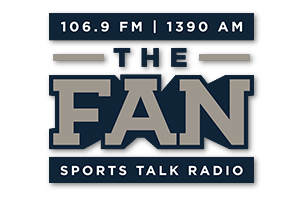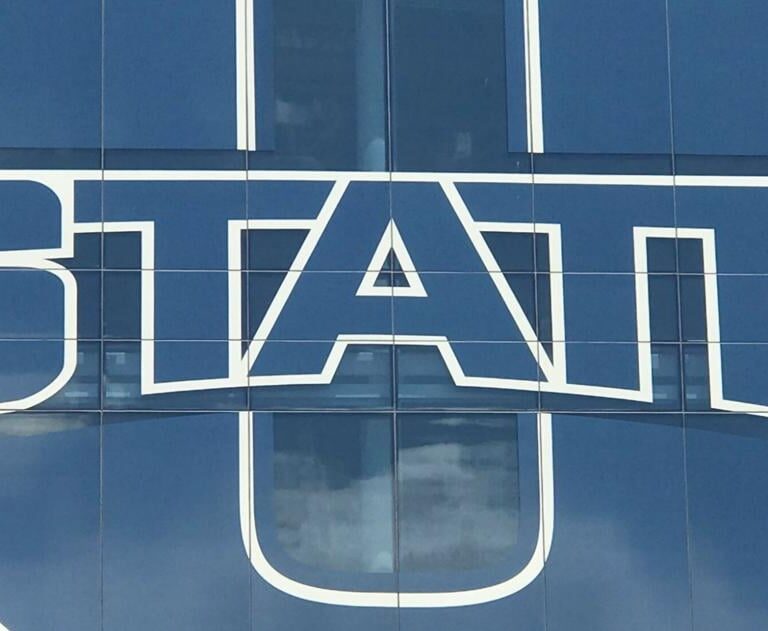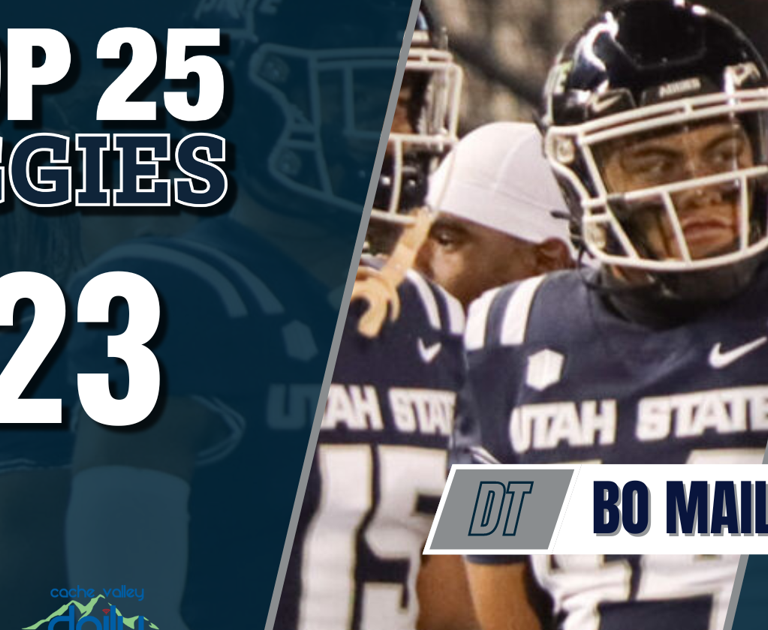As Utah State football coach Blake Anderson sat down to address the media following his team’s thrilling 34-33 win over UConn, one that included a 17-point rally — the fourth largest comeback in USU history — a list of accomplishments regarding recent rallies during Anderson’s tenure was read off for the benefit and reference of the media members assembled. Along with noting that it was the fourth-largest comeback, it was noted that the Aggies have won 13 games under Anderson in which they trailed at some point.
It’s an impressive resume for Anderson and it was well worth pointing out. And there’s some pride to be found in Anderson over his team’s ability to rally and he’s said as much in previous weeks and said so after the win over UConn. But Anderson wasn’t entirely thrilled by those factoids.
“I don’t like any of those stats he just gave you cause that means we’re really really struggling early in the games,” Anderson said.
Slow starts have remained an issue for the Aggies all season. The stats explored in last week’s Monday Cooldown regarding first quarter vs post-first quarter stats could simply be updated. What the heck, let’s do that but this time I’ll use some charts.


Almost nothing has changed for the Aggies when it comes to how their games turn out. Go down one, usually two touchdowns (often giving up more touchdowns early in the second quarter to be down three or more touchdowns), then perform significantly better the rest of the game. It remains true that if you exclude first-quarter points from all of Utah State games, it’d be a 5-0 teams, and would probably be ranked in the AP Top 25 at this point.
A key word in all that though is almost. The difference this week is that the Aggies won. They left the stadium as winners, not needing to exclude fourth-quarter points do make it so. That face changes things, even if only a little bit. The gap between Utah State having a 2-3 overall record vs being 1-4 is a massive one. And the Aggies could hardly have afforded to lose to a UConn team that many rankings, computer-based or otherwise, regarded to be among the worst teams in the country.
The biggest change in the win comes from the narrative going from “How do they turn things around?” to “How do they build off this win?” But being able to build off this first win against an FBS opponent relies on being able to say that USU changed things about itself to enable a victory. The Aggies can’t say that. They defied the old cliché “definition of insanity” quote (that insanity is doing the same thing over and over and expecting a different result) by doing the exact same thing they’ve done for the previous four games (three vs FBS teams) and somehow earning a different result.
One of the most problematic things for Utah State when it comes to winning the first quarter is that it’s not big, physical, talented, or experienced enough to win that battle early, and are too often only able of winning battles at the line of scrimmage after wearing teams down with speed and tempo. Anderson has said in virtually every preview and post-game press conference that his team is or was outmatched physically by their opponent (the lone exception being against Idaho State). This was also a theme last year, heck, it was also a theme in 2021. The Aggies haven’t been big enough in any of Anderson’s three seasons at Utah State.
That, of course, raises the question of why Anderson, in his three seasons, hasn’t been able to develop bigger players and establish a recruiting pipeline of capable players that can meet the challenge of a Mountain West season. Anderson was asked as much on Monday.
“I think where we’re at is just getting used to the (recruiting) footprint we’re in and where we have to go to get those guys up front, especially on the defensive line,” Anderson said. “We’re without (Poukesi Vakauta) right now, he adds some power and size. Some of our defensive ends that we were anticipating with are playing for other people as you guys know and we’re throwing some new guys into the mix. I think it’s a combination of everything. We have been hit by a graduation, transfer portal and we have had some injuries that have created problems. And we’ve got some guys that are gonna be good players, just quite aren’t there yet, haven’t played a whole lot. It’s all of the above.”
The defensive line issues Anderson noted are certainly the biggest the team is facing in terms of both size and experience. Hale Motu’apuaka is solid but he’s not carrying an entire D-line nor demanding a lot of extra attention. And everywhere else there’s inexperience and a lack of size. Seni Tuiaki and Bo Maile, two players getting most of the remaining snaps the last few weeks alongside Motu’apuaka, are both 280 pounds (often being 20-30 pounds lighter than the linemen they go up against) and are both inexperienced. Paul Fitzgerald and Enoka Migao are also both undersized and inexperienced as are two of the other rotation edge rushers, Blaine Spires and Cian Slone. It’s been a struggle all season for these players to cause issues on the offensive line and either make plays or pave the way for linebackers to clean things up for short gains.
The Aggies tried to recruit extra size for the defensive line this offseason. They added Sir Mells (300 pounds), Vaughn Mamea (345), Clifton Mosley (340), K’leyone Iosua (305) and got returner Vakauta up to 305. The room as a whole got bigger but those five players have combined for 181 snaps (for reference, Motu’apuaka has played 170 himself and Tuiaki has played 230 himself). Most of those have gone to Vakauta who is injured and not expected back for a couple weeks. The size Utah State has hasn’t been of any use because those players are either injured or haven’t shown the ability to actually use that size. As a result, the Aggies are constantly undersized and are to inexperienced to get around that obstacle.
This is where losing Daniel Grzesiak, Byron Vaughns and Patrick Joyner Jr. really hurt the Aggies defensively. Had those players returned this would probably be a much different season. But that’s a what-if scenario that isn’t really worth getting into.
Let’s use my favorite method of visualizing the size issue by making a table. I took the average weights of Utah State’s starting offensive line and the players with the most snaps on the defensive interior and most snaps as edge rushers and compared them with the weights of the teams USU’s played at those same positions.
| Position | Utah State | Iowa | Idaho St. | Air Force | James Madison | UConn |
|---|---|---|---|---|---|---|
| Offensive Line | 305.5 | 307.6 | 293.4 | 297.0 | 307.0 | 295.8 |
| Interior D-Line | 283.3 | 297.3 | 276.0 | 283.3 | 278.5 | 298.0 |
| Edge Rusher | 240.0 | 260.5 | 242.8 | 255.0 | 255.0 | 273.5 |
The numbers show that the Aggies are consistently undersized, but not always. James Madison and Air Force are both similarly sized or smaller but have linemen on both sides powering borderline Top-25 teams, but that’s where experiences comes in. Both the Falcons and Dukes returned most of their starters, many of whom were already multi-year starters or rotation players. The Aggies lack that experience in several areas AND lack the size to make up for it. In other words, the worst of both worlds.
With all of this in mind, the tone of the season shifts somewhat. Anderson used the term “rebuilding” in this week’s press conference which is probably the most fitting. The team focused on bringing in guys with multiple years of eligibility left and that meant taking on guys who weren’t ready to be starters and rotation players just yet. We’re seeing the negative consequences of that strategy playing out before us. Perhaps next year the positives will play out.
As a final note, let’s look back on the blocked kick Ike Larsen made. It’s a testament to persistence and finding gaps in opponent’s play, this one being a literal gap. Anderson and Larsen spoke of seeing a weakness in the left side of UConn’s blocking unit (right side from the defense’s perspective). The Aggies’ field goal block unit is a fairly typical look where they overload one side with four blockers that are essentially only guarded by three blockers. Here’s a still-shot of that look.

The key here is for that right edge of the USU formation with Migao (45), Anthony Switzer (1), Ike Larsen (6) and JD Drew (18) is to set up Larsen to spring through by having Drew take on the far outside blocker with Switzer and Migao occupying the next to blockers inside and Larsen can try and jump the gap. This isn’t a novel thing to do. Teams overload a side all the time and field goal units block them perfectly all the time. Against FIU, the Huskies saw a similar look with one of their players trying to make the same jump-through-the-gap move Larsen would eventually pulled off, but you can see the UConn blocker play it well by just sticking out his arm and catching the player, holding him off just enough. The blocker has to block two gaps because of the overloaded look, but he doesn’t have to block both for long. He just needs to buy a sliver of time and does so by closing one gap with his body and the other by reaching his arm out and just catching enough of the defender to keep him from sprinting by.
UConn saw this look several times against FIU and other opponents and played it quite well, but there were inconsistencies with this blocking. You can see hear a hint of the mistake that would eventually allow Larsen to get through to get his game-winning block.
Looking closely you can see UConn’s No. 67, Christopher Fortin, not really effectively play the gap Larsen is playing. Larsen didn’t really exploit it, but it was there. And with a trip to overtime on the line, Larsen had ample motivation to hit that gap as hard as possible.
Larsen couldn’t do this alone, though. It requires Switzer and Migao to occupy all of Fortin’s attention, hitting him as hard as possible to keep his arms on Switzer and away from Larsen. This kind of stuff is the “game of inches” that’s often referred to. All it takes for UConn to go to overtime is slightly less effort from Switzer and Migao and an outstretched arm from Fortin. Then who knows what happens. But spotting a blocker’s inconsistencies on film and in the game and adjusting to exploit it is a skill the coaches should be praised for because it put playmakers like Larsen in a spot where he could do what he does best — make a play.






